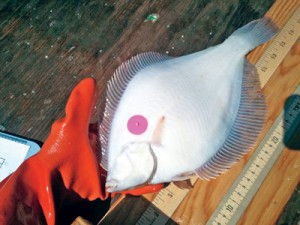ALEXANDRIA, VA – During an update on the 2014 Maine-New Hampshire (MENH) inshore trawl survey to the Northeast Area Monitoring and Assessment Program (NEAMAP) board at the recent Atlantic States Marine Fisheries Commission (ASMFC) winter meeting here, members considered running a comparison of boats, nets, and captains in the overlapping areas between it and the nearby Massachusetts bottom trawl survey.
“Some species are showing a higher abundance north of Portsmouth, but are similar in the south,” said Matthew Cieri, Maine Dept. of Marine Resources (DMR) researcher.


Two views of a tagged flounder during the Maine DMR winter flounder distribution and migration tagged study.
(Keri Stepanek/Maine DMR photos)
Those differences could be due to equipment or could be a possible difference in fish abundance geographically, Cieri said. For example, the lobster index in the Massachusetts inshore survey is stable, while the lobster index in the MENH survey is growing.
The data question exemplifies how the independent-fisheries research works under NEAMAP, a state/federal collaborative effort sponsored by ASMFC.
Both inshore surveys, the MENH and the Massachusetts Div. of Marine Fisheries (DMF) bottom trawl survey which started in 1978, provide their data to NEAMAP to facilitate efficient collection and access to fisheries-independent trawl survey data…

Read the rest of this story and much, much more in the March issue of Commercial Fisheries News. Buy this issue or Subscribe.
(Read online immediately with access key and download for future reference.)







 Updating...
Updating...